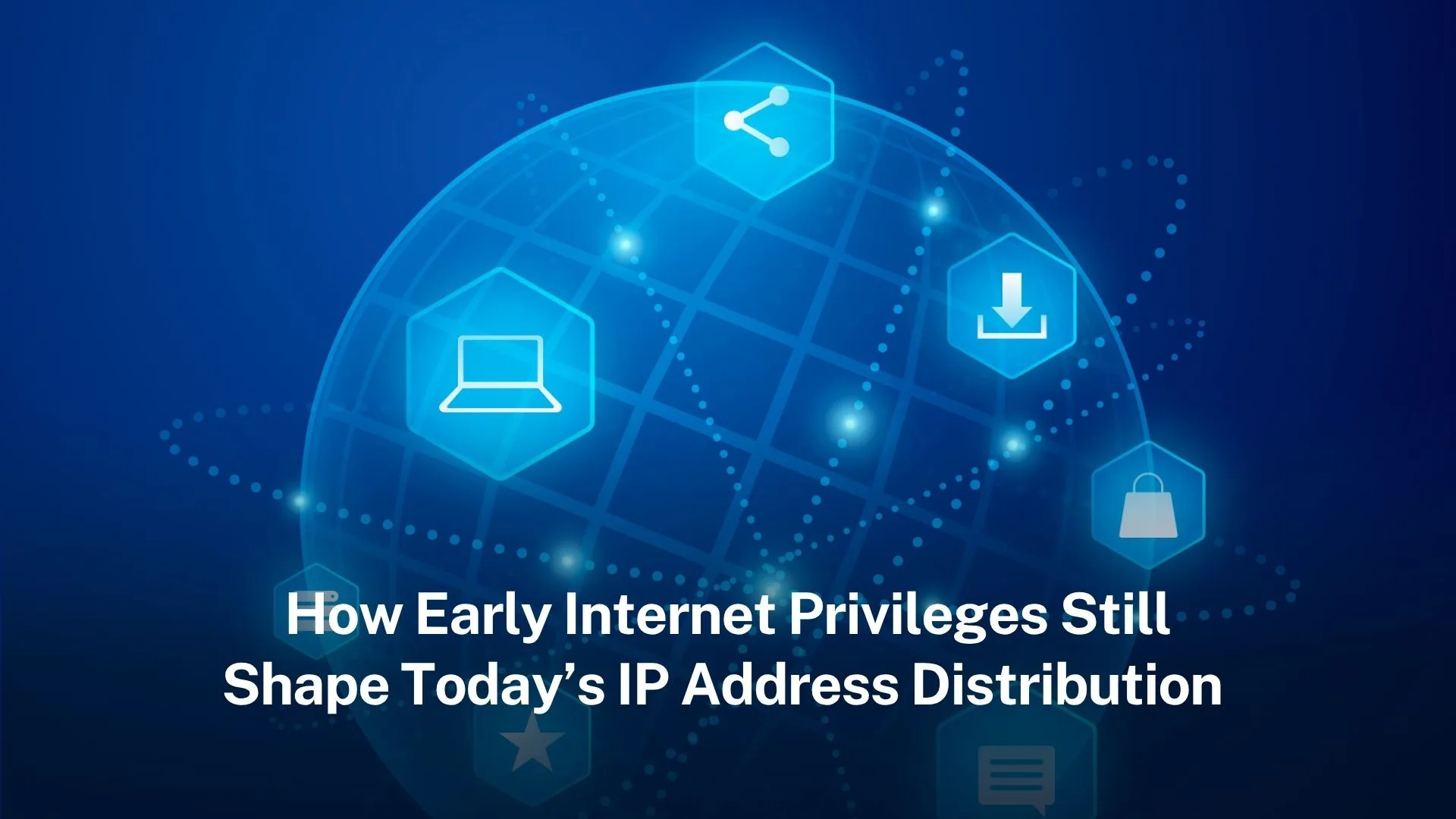Historic allocations of IP address space continue to influence modern internet infrastructure. They affect policy across regions worldwide. They also shape global market dynamics. Legacy allocations created large address blocks. These blocks give strategic advantages to early networks. The lack of IPv4 addresses is a key issue. The distribution of these addresses is uneven. These two factors show early policies still have importance today.
Table of Contents
ToggleOrigins of IP address distribution
The internet’s earliest form emerged in a specific context. That context involved research and defence. It took shape principally in the United States. The time period was the 1970s and early 1980s. The Internet Society has made a statement. ARPANET transitioned from NCP to TCP/IP. This transition permitted a split. One part became MILNET. It supports operational requirements. The other part remained ARPANET. It supports research needs.
During this period, IP address block allocation followed a specific pattern. It was highly informal. The Internet Assigned Numbers Authority (IANA) operated under Jon Postel’s guidance. Applicants simply needed to contact Postel. The purpose was to obtain protocol parameters.
Demand for IP addresses was low at the time. The number of networks was limited. Large contiguous address blocks were distributed. An example is Class A /8 networks. These blocks went to early adopters.
These allocations were made under a specific system. That system is the now-obsolete classful network system. This means certain organisations hold vast address space today.
Certain regions also hold such space. The space dates back to that early era. Class-A, -B and -C designations served a purpose. They ensured large institutions received generously sized blocks.
How early allocations create legacy advantages
Today’s internet infrastructure still reflects early ownership patterns. Organisations obtained large address blocks in the early era. They can leverage these blocks for specific benefits. One benefit is hierarchical routing advantages. Another is advertising advantages. Fewer prefixes lead to a specific outcome. They reduce the size of global routing tables. They also lower operational costs. These costs are for network operators.
Newer entrants face different conditions. They encounter stricter policies. The Réseaux IP Européens Network Coordination Centre (RIPE NCC) has published policies. These policies show a trend. During the later stages of IPv4 allocations, regional registries implemented new rules. One rule is minimum-size blocks. Another is stricter eligibility criteria. Early recipients of large blocks benefit from legacy conditions. This phenomenon can be described as “first-mover IP privilege.”
Legacy address holders sometimes use their blocks as assets. They can lease excess allocations. They can sell them. They can transfer them. These actions are allowed under certain regional policies. Regional restrictions may apply. IP brokers play a role. They facilitate the market for legacy IPv4 space. This market exists in regions where IPv4 exhaustion has set in.
IPv4 exhaustion and the impact of legacy allocations
IPv4 address space has a finite nature. This means early allocations have become increasingly valuable. Scarcity of IPv4 was well recognised. The recognition began in the early 1990s and continued beyond.
The document “Beginner’s Guide to Internet Protocol (IP) Addresses” made a note. IPv4 has approximately four-billion addresses. These addresses served the internet for decades. They are insufficient today. The modern network is vastly larger.
As the pool of unassigned IPv4 addresses neared exhaustion, regions took action. They developed policies. These policies manage the “last /8” of IPv4 addresses. They also regulate the use of address transfers. In the RIPE region, a specific policy section applies. Section 5.6 governs how allocations from the final /8 are handled.
Early large-block recipients hold strategic advantage in this environment. They may have address space. Newer entrants must acquire this space. They do so on secondary markets. They often pay a premium cost. This reinforces unequal distribution. The inequality is rooted in early privilege.
Regional disparities and historical legacies
The legacy of early allocations contributes to specific differences. These differences relate to address distribution. They also relate to market dynamics across regions. Some regions had major early research-network presence. North America and Europe are examples. These regions secured large blocks early.
Other regions followed a different path. They joined the internet growth curve later. They found themselves subject to stricter quota systems. They received smaller allocations.
This disparity has regulatory implications. Policymakers face a live question. The question concerns fairness in resource allocation. This is especially relevant as IPv6 transition takes place. It is also relevant as legacy IPv4 blocks are traded. The playing field is uneven. Some regions and organisations adapt more easily. They handle scarcity better. They navigate secondary markets more effectively.
The issue is not solely about the quantity of addresses. Infrastructural routing plays a role. Aggregation efficiency matters. Historical network design is also a factor. Legacy block holders may benefit from specific advantages. These include more favourable routing aggregation. They also include reduced visibility in global tables. These benefits give them operational advantage.
The shift to IPv6 and how legacy IP impacts still persist
IPv6 was designed to address IPv4’s limitations. One key limitation is the scarcity of address space. Legacy issues continue to matter. IPv6 adoption has progressed. The progress is uneven across regions.
IPv4 remains dominant in many networks. It remains dominant in many regions. Legacy allocations retain high relevance. Constraints around IPv4 transfers also remain relevant. Organisations with large IPv4 holdings have options. They can monetise their holdings. They can face fewer scarcity pressures.
Newer networks face different challenges. They must contend with address markets. They deal with transfer policies. They encounter higher costs. Many systems’ architectural design reflects IPv4 assumptions. Historical privilege is built into the address ecosystem. It remains embedded in routing tables. It is present in organisational resources. It influences market behaviours. The legacy dimension must be addressed. Without this, any transition risks reinforcing old inequities. These inequities may take a new form.
Why early IP privilege matters for today’s internet
Legacy advantages in IP allocation translate into real-world benefits. These benefits are both market and technical. Address space functions as an asset. The secondary market for IPv4 space demonstrates this. IP resources are traded. They are valued. A blog on IP brokers’ handling of legacy IP resources provides insight. Brokerage firms manage specific activities. They handle the buying of legacy IPv4 space. They manage selling and leasing. These activities occur in exhausted markets.
From a broader perspective, early distribution decisions shape the internet’s architecture. Network operators hold large contiguous blocks. They enjoy simpler routing. They benefit from better aggregation. They face lower overhead. These factors may translate into cost benefits. They may also lead to performance advantages.
In policy terms, these inequities challenge specific notions. The notions relate to global fairness. Some actors hold privileged resource allocations. Their advantage comes simply from being early. Resource distribution may not align with current needs. It may not support equitable access. IoT is growing. Mobility is expanding. Billions of new connected devices are coming online. Addressing these legacy issues becomes critical. It is necessary for scalable infrastructure. It is necessary for fair infrastructure.
In technical terms, the transition to IPv6 will reduce reliance. The reliance is on legacy IPv4 holdings. This will happen eventually. Until then, legacy effects remain active. The IEEE paper “Phase Changes in the Evolution of the IPv4 and IPv6 AS-Level Internet Topologies” provides evidence. The IPv4 network entered a mature growth stage. IPv6 followed a different dynamic.
Future implications and approaches
Addressing legacy allocations is not straightforward. There are no easy “reset” buttons. Regions and registries may consider specific policies. One option is stricter transfer restrictions. Another is incentives for IPv6 migration. A third is resource “re-balancing” mechanisms. Each approach carries complexity. The complexity is technical, legal and political.
Some ideas have been proposed. One is improved transparency around address space ownership. Another is certification of routing authority. This can be done via resource certificates. A third is stronger governance of transfers. The concept of resource certification has been described. It is an objective to “unambiguously identify the unauthorized use of IP number resources…” This description comes from the Internet Protocol Journal.
Ensuring legacy allocations do not create unassailable advantage is key. It is key for the internet’s future growth. Policymakers and network operators must make a balance.
They weigh historical rights. They consider current equity needs. They also factor in scalability requirements.
FAQs
1. Why were large IP address blocks allocated early in the internet’s history?
Early networks had far fewer nodes. They had looser governance. Generous, large-block allocations were allowed. They followed the classful system (A, B, C networks).
2. What is the difference between legacy IP allocations and current policy allocations?
Legacy allocations had minimal eligibility criteria. They came with large block sizes. Modern policy operates differently. An example is policy from RIPE NCC. It involves stricter criteria. It includes minimum block sizes. It incorporates resource conservation measures.
3. How do legacy IP allocations affect network operators today?
Operators with legacy large blocks gain specific benefits. They benefit from routing aggregation. They gain asset value in IPv4 markets. They face lower administrative overhead. Newer entrants encounter different circumstances. They receive smaller allocations. They face higher costs. They have less aggregation efficiency.
4. Will IPv6 eliminate the advantages of legacy IPv4 holdings?
Eventually, yes. IPv4 remains widely used. Legacy holdings still confer benefits. The transition to IPv6 does not immediately erase the legacy advantage. The architecture of many networks remains IPv4-centric.
5. What policy responses exist to mitigate legacy privilege in IP address distribution?
Policy options include specific measures. One is transparency of address-space ownership. Another is stricter transfer and re-allocation rules. Incentives for IPv6 adoption are an option. Mechanisms for re-balancing address resource distribution are also possible. These mechanisms apply across regions and organisations.




